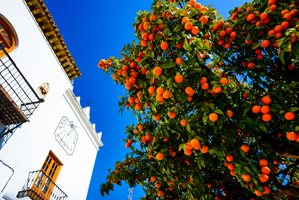
It was said of the Muslim invaders of southern spanish cities “they were never happy where the olive did not grow.” I think of that phrase when I’m enjoying a plate of oily olives and a glass of wine while I wait for paella in an elegant eatery in the El Arenal neighborhood of Seville. From here I have an excellent view of La Giralda, one of Andalusia’s most recognizable structures. Like the spicy rice infused with lemon I’m about to enjoy, La Giralda is an excellent example of the enduring legacy of Andalusia’s Islamic or Moorish period.
Historians find it tricky to put a name to the Islamic presence in the Iberian Peninsula, which lasted from the Umayyad conquest in the early eighth century to 1491 when Ferdinand and Isabella — the Catholic Kings— reconquered Granada, the last Muslim stronghold. Spanish historians and patriots refer to the entire 780-year period as the Reconquista or “reconquest,” a never-ending struggle not only to reconquer Al-Andaluz from the Moors but also to unify the patchwork quilt of Spanish principalities into a mighty nation. This idea is a foundation story that still resonates today in modern Spain.
Muslim and Jewish historians, on the other hand, look back with nostalgia to a Golden Age of science and culture. These were days when Cordoba was the largest city in Europe and the continent’s unrivaled center of scientific learning, particularly in mathematics, medicine, and astronomy. It was in Al-Andaluz that the “father of surgery” al-Zahrawi wrote his famous treatise on surgery that included some two hundred surgical instruments, many invented by al-Zahrawi himself. In the sphere of astronomy, Al-Zarqawi invented the sahifah, a flat astrolabe. Andalusian scientists also applied themselves to practical matters such as botany, pharmacology, and horticulture.
Significantly, the Andalusian scholars were not exclusively Muslim. Their policy of tolerance to all conquered peoples extended special privileges to the “Peoples of the Book,” or Christians and Jews, who managed to coexist with their Muslim rulers peacefully. Jewish scholarship benefitted from the centuries of tolerance, and Andalusia produced some the most celebrated Jewish thinkers such as Judah Ha—Levi and Maimonides. These scholars not only pioneered their subjects, but also left a legacy of translations of their work into Hebrew and Latin, which would prove invaluable to future generations. Spain’s success with the voyages of discovery owe a great debt to the scholars of Andalusia.
Traveling through Andalusia today, the tangible and intangible legacies of the Islamic presence in Spain remain in plain sight. You see it in the ubiquitous jasmine and orange trees, the intricate geometric mosaics and tiles, and the quiet courtyards with their gurgling fountains, prized by a desert people who delighted in the abundant water flow from the snow-capped Sierra Nevada Mountains. You sense the pride of craftsmanship in the exquisite interiors of Cordoba’s Mezquita and the lush solitude of Granada’s Alhambra. You can feel it in the languid sensuality of Andalusian music. The very rhythm of the day with its noontime rest from the hot sun, and the celebration of food and friendship in the evening - with delectable food redolent with Middle Eastern accents of hot peppers, saffron, oranges, and lemons.
Discover the delights of Spain on Alexander + Roberts’s
Spain by Rail itinerary, a private rail journey for departure on any day that includes visits to Seville’s Real Alcazar, as well as stops in Madrid and Barcelona. Speak to one of our knowledgeable reservations agents about your next spain train tour.